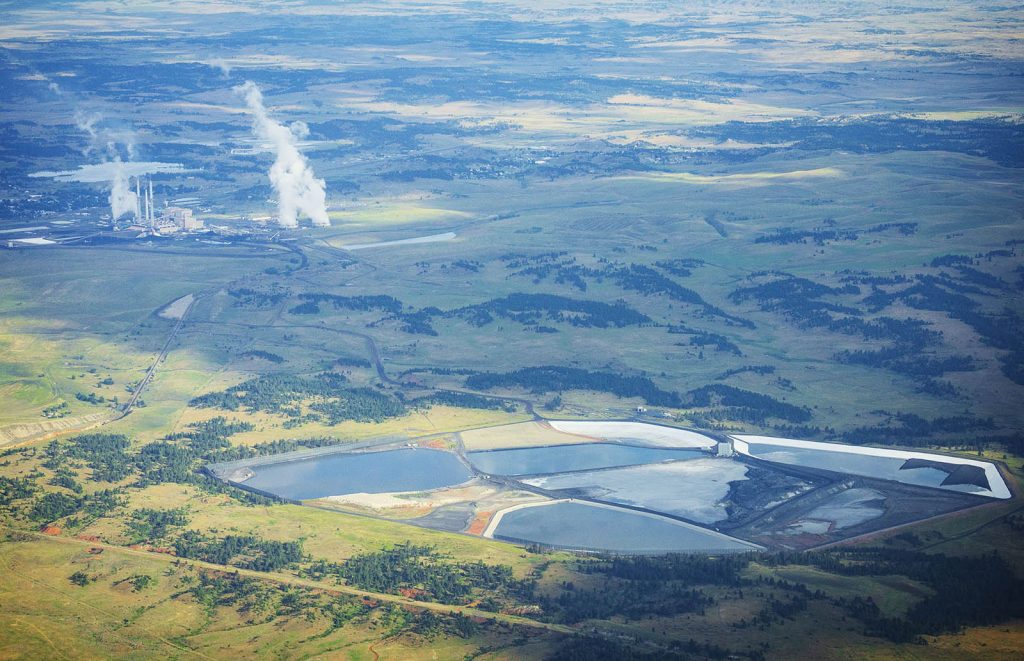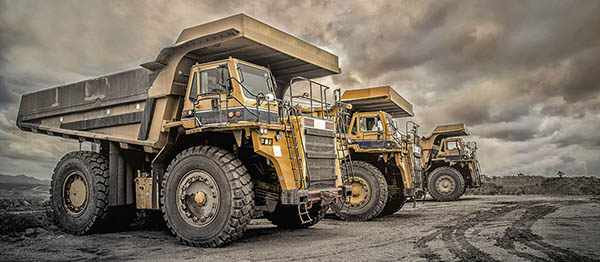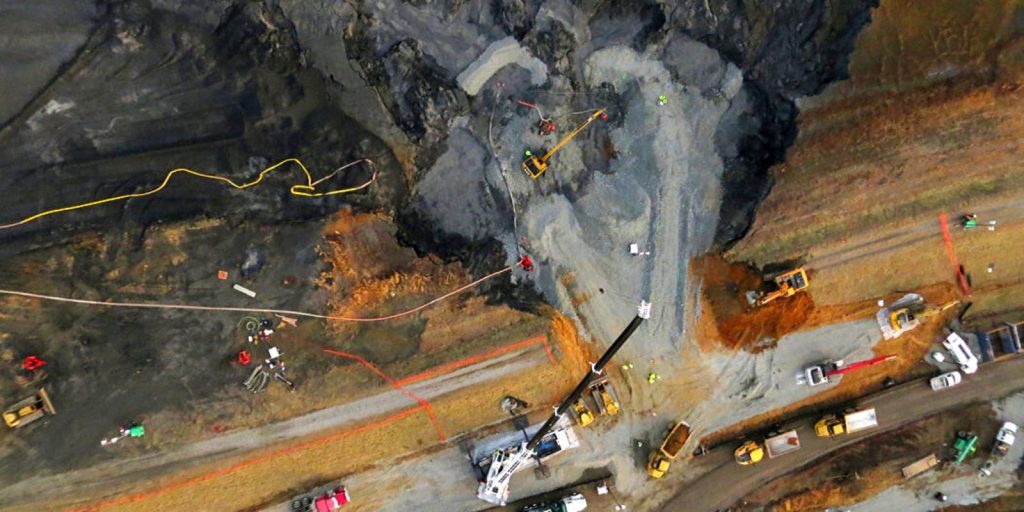The EPA reverses course on closing dangerous coal ash ponds, and submits rule changes that threaten public health.
Above: Coal ash pond breaches are becoming more common and more dangerous as climate change creates more erratic weather.
The Trump Administration is accelerating its efforts to dismantle the few regulatory barriers that protect the public from toxic coal ash waste. Minerals in coal ash (the ash left over after burning coal) including arsenic, mercury, thallium, lead, and many other elements make coal ash one of the most dangerous pollutants in America, causing respiratory illness, neurological damage, and cancer. WORC is tracking the bevy of proposed rule changes to the 2015 Coal Combustion Residuals [CCR] Rule, the only federal law that controls coal ash handling and disposal. And because coal ash is the second largest industrial waste streams in the US, these rollbacks impact nearly every state in the country, including in our western region.
Three rounds of rollbacks, and more on the way
In November 2019, the EPA announced a massive new set of changes to two coal ash management regulations: one proposal changes the Effluent Limit Guidelines (what levels of toxins plants can discharge into public waterways under the Clean Water Act) and the other changes the 2015 Coal Combustion Residuals Rule [CCR Rule], a proposal which the EPA refers to as “Part A”. This latter proposal is the third set of rollbacks to the CCR rule – and it won’t be the last.
The CCR Rule Proposal Part A essentially allows utilities to keep the worst ponds open and receiving ash for many more years – in particular, unlined ponds and ponds that are located in dangerous areas. These were originally scheduled to close in April 2019, but previous actions by the Trump EPA pushed it back to 2020 and this new proposal extends these deadlines for many, many more years. A public comment period is open until January 31, 2020.
TAKE ACTION: Speak out against the gutting of CCR Part A, Docket Numbers EPA-HQ-OLEM-2019-0172 and FRL-10002-02-OLEM CCR.
The ELG proposal is an attack on the Clean Water Act’s Effluent Limitation Guidelines (ELG) program, which authorizes the EPA to set pollution limits for discharges from industrial sources – including coal plants. These limits were only just established in 2015, but the Trump EPA has already delayed compliance timelines from 2018 to 2020. This latest proposal would allow for significantly higher levels of pollutants to be discharged into rivers and lakes – many of which serve as public drinking water sources. A public comment period for this change is open until January 21, 2020.
TAKE ACTION: Speak out against weakening the Clean Water Act’s Effluent Limitation Guidelines (ELG) Proposal, Docket ID: EPA-HQ-OW-2009-0819
This is only the latest iteration in a coordinated dismantling of the CCR rule. The Environmental Protection Agency has already proposed two previous rounds of rollbacks to the CCR Rule – both of which were designed to save the utility industry money and ignore public concerns. The first proposal weakened groundwater protection standards, extended closure timelines for leaking ash ponds, shortened post-closure maintenance requirements and gave states more authority over permitting (which is not great in most cases, since states vary greatly in terms of their desire and/or resources to rigorously enforce good closure requirements). This proposal was approved and finalized in 2018. The second set of rollbacks removed nearly all restrictions for so-called “temporary” coal ash waste piles and allow for unlimited amounts of coal ash to be used in construction projects (beneficial reuse). The EPA has announced it will finalize changes from the second proposal in April 2020.
Deep Dive into CCR Part A
The EPA is calling this round of changes: “Proposed Changes – A Holistic Approach to Closure Part A: Deadline to Initiate Closure.” Under the Part A proposal, plant owners will have much more time to keep unlined, leaking coal ash ponds open, allowing them to continue receiving ash for up to 4.5 additional years. The ponds in question are those that are unlined and those that violate the 2015 CCR rule’s location prohibitions, like being located next to a wetland, within 5 feet of an aquifer, or in a geologically unstable area (over a fault or in a seismic impact zone). These very ponds were identified as priorities for closure because they pose serious dangers to the public and are the source of massive water contamination. Obviously, a huge reservoir filled with toxic heavy metal waste probably shouldn’t be located in an area prone to earthquakes or next to a wetland. Likewise, an unlined pit filled with toxic coal ash and contaminated water with a history of contamination is pretty darn likely to continue saturating the surrounding soil and polluting nearby groundwater sources. Giving the industry several additional years to continue operating these ponds will inevitably save the industry some money, but at an appalling risk to public safety.
Giving the industry several additional years to continue operating these ponds will inevitably save the industry some money, but at an appalling risk to public safety.
Under the original Obama era rule, most of these ponds would have had to stop operating and begin closure steps in April 2019. That deadline was originally pushed back by the Trump administration to August 2020. The new Phase 3 proposal allows utilities to push the deadline back to October 2023 if they can convince regulators that they need more time to properly dispose of the waste. On top of that, if a company plans to shut down a coal boiler, they can petition to keep its ash ponds open and receiving ash for as long as eight years. Coal ash ponds smaller than 40 acres could stay open until October 2023 and larger ones could stay open until October 2028. And that’s just the dates for starting the closure process. Some ponds would not have to complete closure until 2038. The rollback makes it much easier for companies to get these extensions to continue operating dangerous and leaking ponds.

CCR Rollback Analysis for our Region
A number of plants in our region will be freed up to continue operating and receiving ash into these unlined, unsafely sited ponds. Not only are these ponds leaking toxic elements, some of them even have significant hazard ratings from the EPA meaning that they pose a significant threat to public safety due to the risk of dam failure like the 2008 Tennessee Valley Authority disaster.
For our region, this will significantly change the closure dates for ponds at seven plants located in Wyoming, Montana, North Dakota, and Colorado. Some of these, like the Jim Bridger and Naughton plants in Wyoming, are considered some of the worst groundwater polluters in the country. A quick glance at the worst ponds that will be given extensions under these CCR rollbacks illustrates the threat of the EPA’s proposal.
The South and North Ash Ponds at the Naughton Plant in Kemmerer, Wyoming, are unlined, which means that coal ash and contaminated water are stored in a pit where it leaches out into the surrounding soil. Groundwater monitoring data supplied by the owner (PacifiCorp) to the EPA shows lithium and selenium exceeding safe levels by more than 100 fold, and arsenic at five times above safe levels. On top of all this, the EPA rated the pond as a “Significant” hazard, meaning that it poses a threat to public health and safety. Over 8 million cubic yards of coal ash is stored at the South and North Ash Ponds – both of which will be allowed to operate for several more years under the EPA’s new proposal.
Ponds at the Jim Bridger Plant pose similar dangers to the environment and public. The unlined Flue Gas Desulfurization (FGD) Pond 2 contains 8 million cubic yards of coal ash, which has contaminated groundwater with alarmingly high levels of arsenic, boron, cadmium, cobalt, lead, lithium, molybdenum, radium, selenium, sulfate, and thallium – some of which are 100 times over groundwater standards. And again, the EPA gave the pond a significant hazard rating
Finally, the Laramie River Station has five unlined ponds that store over 3.5 million cubic yards of coal ash and all five ponds have a significant hazard rating. Groundwater monitoring shows unsafe levels of lithium and molybdenum contamination. There is no closure date set for these ponds. And as in the case in many coal ash areas, the communities located nearest to the plant have a significantly higher percentage of low-income households than the rest of the state.
Weakening the CCR rules is a corporate handout that puts the public in significant danger. Now is the time to speak out. Here are the links to CCR Rule Proposal Part A and Effluent Limitation Guidelines (ELG) proposal comment pages to take action. WORC will continue monitoring these rollbacks and will post as things develop.
Read more stories about coal here.
Learn more:
“Doing It Right” Means More Jobs For Colstrip And Around The United States
Fixing Abandoned Mine Sites Is Essential For A Transition Economy
Dramatic Results In South Carolina After Coal Ash Removal

Help create a healthy and sustainable West. Support WORC today.

